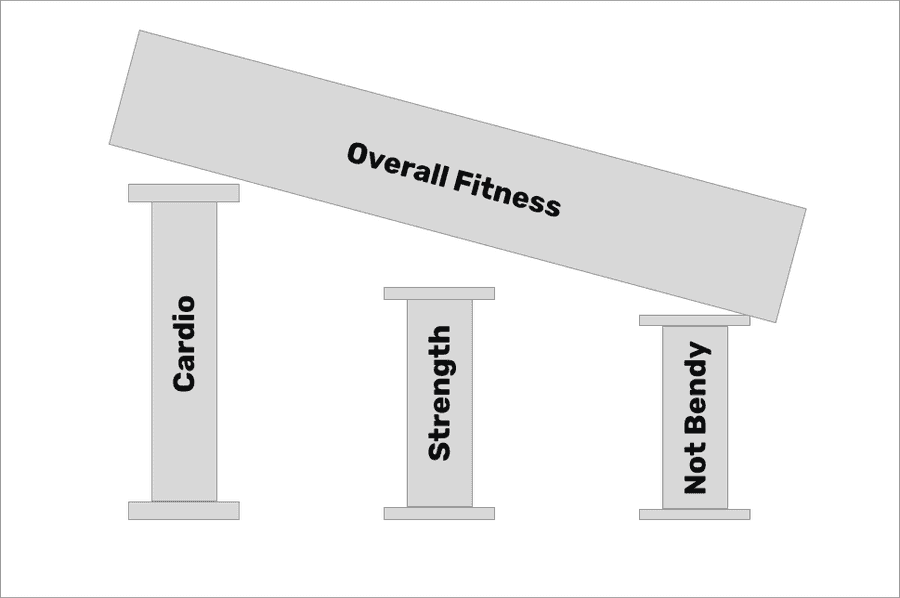
When it comes to overall fitness, we want people to have a solid grounding in three main areas: Cardiovascular fitness, strength, and mobility. There are semantics and divisions among these that people will happily debate for entire careers, but generally humans do pretty okay when they run around a little bit, lift heavy things occasionally, and put their joints through a full range of motion. It makes a lot of sense to imagine these as three pillars holding up your fitness.

Of course, we have some outliers— people who want to do a little more than just be pretty okay. We have people that want to run 100-milers in the woods. We have others trying to throw 500 pounds overhead. We even have people practically tying themselves into knots. While this is all well and good, from a health standpoint, being excellent at something causes a risk to overall fitness and even health. There are stories of lifters who have trouble going up a flight of stairs, and marathon runners with a 2 inch vertical jump. I’ve treated loosey-goosey yogis who have pain just standing up because they have difficulty stabilizing their overly mobile spine.
Since this article was meant for runners, if we look at our pillar analogy again, especially for our average runner, it seems that fitness is teetering on an edge:

All it will take is a little overtraining, a tweak, a real injury, and we see that fitness teeter over, crash and burn. With that mindset, I would argue a little bit of flexibility training, and a little bit of strength training is necessary for all athletes, but especially our runner friends. The best news is that it shouldn’t take a lot. In fitness, we often see a law of diminishing returns. As we get excellent cardiovascular endurance or strength, it takes a lot more effort to get it any better. Conversely, if we don’t start with a huge baseline of strength, a little bit of novel training goes a long way.
Let’s get into some general recommendations on strength training for runners. While there are about as many different strengthening exercises as there are types of fish in the sea, a pretty complete program for anyone will have some kind of the following:
- squat: air squats, back squats, goblet squats, etc
- hinge: deadlifts, kettlebell swing, single leg deadlift, etc
- upper body pull: pull ups, rows, etc
- upper body push: pushups, bench press, military press, etc
- weighted carry: farmers walk, waiters walk, etc
- maybe a lunge
The majority of medical professionals (American Heart Association, American College of Sports Medicine) all recommend performing resistance training at least 2x per week, and from my experience, that’s about the most I’ll end up talking an endurance athlete into anyway. Typical suggestions include 2-3 sets for each of these exercises and it should be heavy enough that you feel fatigued within 8-15 reps. At the end of the day, strength training can be as complicated, or as easy as you choose to make it. Just getting in and doing it is half the battle.
While the big, global and general movements work for most people, endurance athletes aren’t most people. Most of the time, a general movement is great, and sometimes a more specific one is necessary. In addition to global strength training, if I ran the world, I’d force all my runners to work on two specific muscle groups:
- Lower abs
- Hip abductors
While these muscles are addressed in the global movement patterns, a little bit of accessory work for these groups would be perfect. In the name of convenience, I’m a huge fan of all planking for my runners. If done properly (form perfect), side planks can get just about everything working quickly. On top of that, we add an easy monster walk series to strengthen the side of your hips and we’re in business.
The important thing for most of us is just to make sure we do it. For anyone that feels hesitant about jumping into it, the majority of personal trainers, or just an experienced friend can likely help decode some of these terms and help you get started. Just building this base can have huge kick backs in terms of injury prevention and overall power output. At the end of the day, being stronger can keep you running more, and running faster. I hope the article helps, and happy training to you all.



